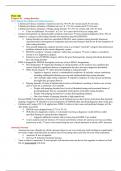Class notes
Chapter 10 - Eating Disorders
- Course
- PSYC 300A
- Institution
- University Of British Columbia (UBC )
Explore the lecture notes on eating disorders. Gain insights into the complexities of anorexia nervosa, bulimia nervosa, and binge eating disorder. Delve into diagnostic criteria, symptoms, and contributing factors. Examine psychological, societal, and cultural influences on disordered eating. Disc...
[Show more]



